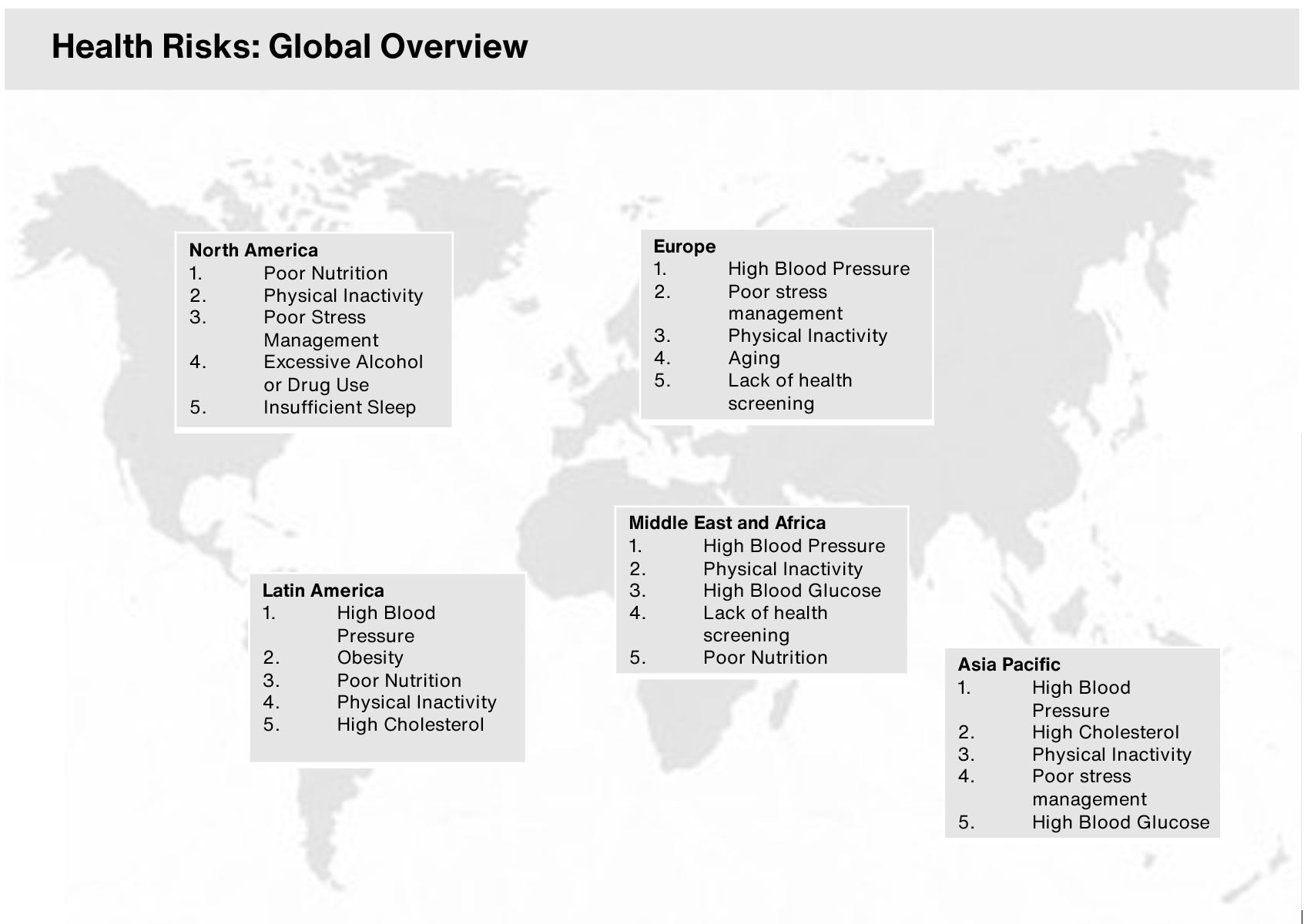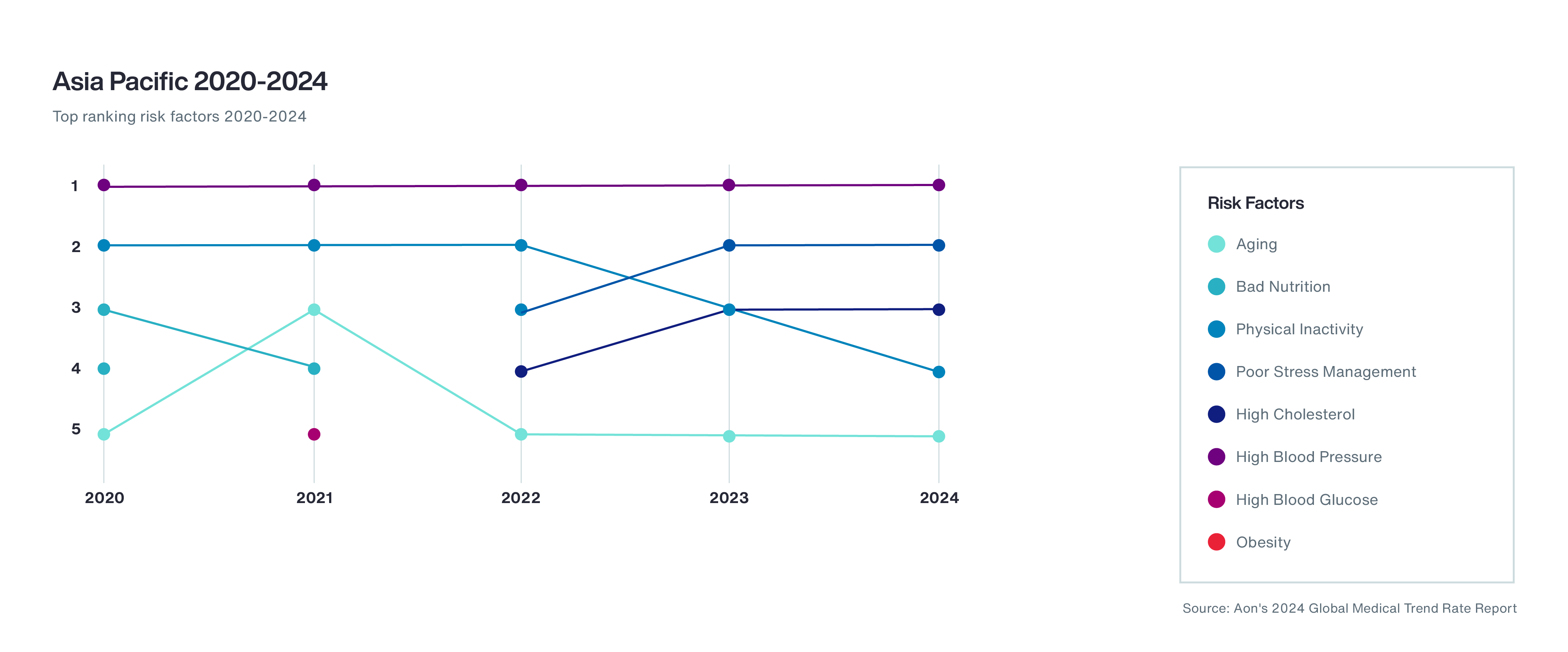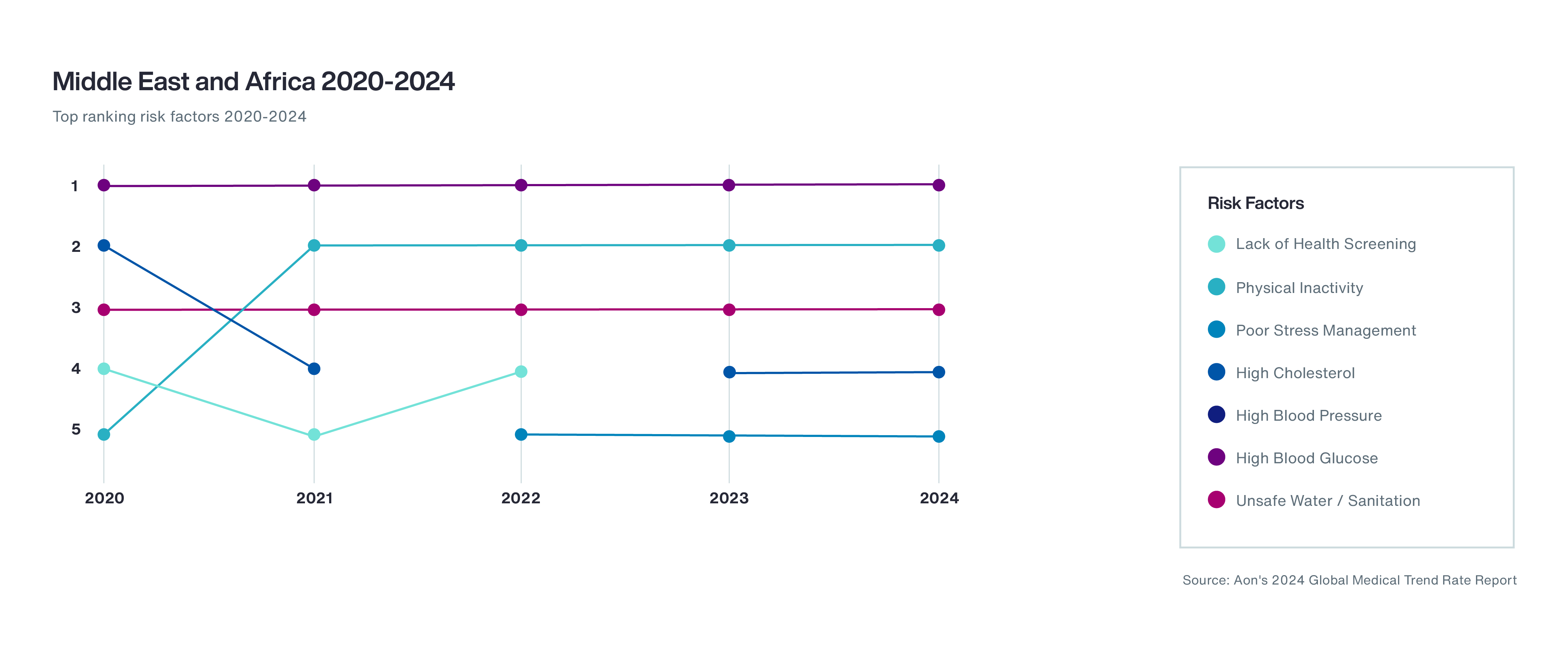More Like This
-
Report
The Global Medical Trend Rates Report 2024
-
Capability Overview
Health and Benefits
-
Capability Overview
Global Benefits

With widespread economic uncertainty and volatility blanketing most of the world, it should come as no surprise that the 2024 global average medical trend rate, at 10.1 percent, was higher than the previous eight years. But beyond macroeconomic conditions, it is worth exploring what is driving this increasing rate, including risk factors and conditions affecting claims data.
The top risk factors underlying the conditions driving claims, and the increasing medical trend rate, can work alone or in combination with each other. Many conditions share common risk factors, which can also exacerbate other risk factors on the list.
Hypertension, or high blood pressure, is once again the leading risk factor globally. It was mentioned as a top-five risk in 80 percent of the countries surveyed. Screening for hypertension is easy and widespread, allowing for early detection and diagnosis. While there are some differences in what regions consider hypertension, those differences are seemingly narrowing.1 Hypertension is unique in that it is both a risk factor for other conditions and a condition worthy of concern itself.
Contributing to hypertension is poor stress management — another top five risk, ranking third overall globally. It can be said that this is the most interactive of the risk factors. Not only can stress lead to many other risk factors and the associated conditions, but it can also raise blood sugar and blood pressure. Stress management can additionally be linked to other identified risk factors like physical inactivity, bad nutrition and drug/alcohol consumption. Some research even suggests that stress is related to cancer and autoimmune disease. The COVID-19 pandemic revealed a lack of parity between services for mental health and those for physical health. Despite pressure from government regulators, not all insurers provide coverage for mental health issues. This lack of support is yet another reason why poor stress management is a prevalent risk factor around the world.
The pandemic also led to several lifestyle changes, such as less physical activity, now the second most prevalent risk factor globally. Physical inactivity can lead to musculoskeletal issues, obesity and cardiovascular problems.
High cholesterol and poor nutrition round out the top five risk factors globally, ranking fourth and fifth, respectively. Like high blood pressure, high cholesterol is a significant risk factor for cardiovascular issues. Also like hypertension, the intervention for high cholesterol can be medicinal, diet-related or both. Poor nutrition as a risk factor is linked to other risk factors like hypertension, high cholesterol and obesity, as well as many of the top conditions.
While the top five risk factors globally were similar across regions, variations do exist — some specific to regional circumstances and others specific to culture.
Issues associated with an aging population were of greatest concern in Europe, where the workforce is aging rapidly resulting in a multigenerational workforce dealing with a wide array of health conditions.
Report
The Global Medical Trend Rates Report 2024
Capability Overview
Health and Benefits
Capability Overview
Global Benefits
High blood glucose was reported as a key risk in both Asia Pacific and the Middle East and Africa, likely linked to stress and bad nutrition. Meanwhile, obesity was the second top risk in Latin America, which is unsurprising since poor nutrition and physical inactivity were also top risks in that region.
Rounding out the top risks within regions is lack of health screening, which was a top risk in both Europe and Middle East and Africa. This is critical, as many conditions will worsen the longer detection is delayed.
It’s important to remember that these rankings are not definitive. For example, high blood glucose may not always show up as a risk factor like hypertension. This may only become apparent after a diagnosis and the treatment has started. Additionally, the public health infrastructure in a region is likely to affect what risk factors and conditions are treated, thereby driving the medical trend rate in region. For example, Europe’s mental health infrastructure is more developed than that of other regions, thus mental health issues will more often be the subject of claims.

The top five risks stayed the same from 2023. Poor nutrition and physical inactivity have historically been and remain major risk factors in the region, contributing to obesity as a top risk factor in the U.S. 42 percent of the population in the U.S. is considered obese, which increases annual medical costs by almost $2,000 per adult.2 Although Canada has not reached the same obesity levels as the U.S., it is still more common than in other similarly wealthy and developed countries.
Poor stress management is reported as a top health risk in both countries for 2024. It has notably been a top three risk factor for three consecutive years in Canada, impacting claims related to autoimmune diseases and mental health.
In the U.S., excessive alcohol or drug use is an important risk factor. Excessive alcohol or drug use has been reported consistently since the COVID-19 pandemic started in 2019, resulting in an associated increased risk of injuries and chronic diseases, such as liver disease, heart disease and several types of cancers.
Meanwhile, insufficient sleep is a top risk factor in Canada, likely linked to high stress. This then contributes to poor overall health. Canada also noted a lack of health screenings as a key risk. In fact, this has been the top risk factor in country for a third consecutive year, resulting in increased rates of chronic conditions and claims.

In Europe, the top five risk factors remain consistent compared to 2023. These are mostly related to socioeconomic factors and lifestyle behaviors, coupled with low awareness of preventive measures and health promoting behaviors.
High blood pressure is the single most relevant risk factor driving future adverse medical claims. According to Eurostat, more than one in five Europeans has high blood pressure3; the largest contributor to cardiovascular disease, which is also the largest cause of death in the region.
Continued economic uncertainty and global conflict have kept stress-related health concerns high in the rankings.
An aging population has a dual effect, both with the rise of diseases affecting the elderly and the lack of resources in the public healthcare system. National health systems are already under strain in a large set of countries, significantly impacting preventive care and early disease identification.

High blood pressure has consistently been the top health risk in the region for the last several years. As a major risk factor for cardiovascular diseases, this poses a significant public health concern, affecting a significant part of the population. It is also a leading cause of premature deaths in the region.4 Although both high blood pressure and high cholesterol are treatable risks, a lack of awareness around this health concern presents challenges.
Poor stress management has also been identified as a key risk factor in recent years, largely due to inadequate awareness of mental health concerns, along with the social stigma and lack of available care. With ongoing economic and political pressures, prevalence of high stress levels, depression and anxiety will continue to rise, amplifying the widespread decline in physical health.
Lack of physical activity in the region ranges from 15 percent to 40 percent by country, as reported by the World Health Organization (WHO). This continues to be a top health risk concern, as it is closely associated with heart disease, stroke and cancer.
For the first time since 2021, high blood glucose was named as a top risk factor in the region as well. High blood glucose interacts with other health risks including stress and physical inactivity, which can both raise glucose levels.

High blood pressure affects between 20 and 40 percent of the adult population in the region. It is not only a leading risk factor for future medical claims, but also a leading chronic medical condition itself, requiring treatment and driving claims costs. Hypertension is followed by obesity and poor nutrition, all of which are interrelated risk factors.
Obesity has grown as a risk factor during the last five years. It has been observed in 79 percent of the countries in the region in 2023, similar to high blood pressure. According to the Pan American Health Organization, around 58 percent of the population is overweight, with particularly high prevalence among women and children.
Poor nutrition is a double burden, as it is a top risk factor as well as a major driver for obesity in the region. The presence of physical inactivity and high cholesterol, the remaining risks factors in the top five, are directly associated with cancer, cardiovascular diseases, diabetes and hypertension — the primary triggers of medical costs in Latin America.

High blood pressure and high blood glucose continue to be key health risks in the region. Both risks are associated with obesity. Despite not showing as a top risk factor, obesity is prevalent throughout many Middle East and North African countries. According to the WHO, this is where some of the highest obesity rates in the word are found, ranging from 26 to 38 percent, with levels significantly higher for woman.
High blood pressure is estimated to be the most common in Africa, at 46 percent according to estimates from the WHO. These levels are associated with poor rates of detection, treatment and control. This is then exacerbated by poverty — the underlying reason for the lack of access to patient care in many of the Sub‐Saharan Africa countries.
Like in every other region, physical inactivity is also a top risk here, exacerbating other prevalent risks and conditions. Poor nutrition and lack of health screening, two risks also associated with poorer populations, complete the top five risks in the region.

Even as the COVID-19 pandemic has receded, healthcare systems are still trying to find efficiencies and refocus their care. This has led to undue optimism that the medical trend rate is more stable now than it will be in the predicted future.
Plan sponsors must use reliable data to help control costs and provide high quality benefits. Doing so will reveal what members need, how members use care and how they can help their members be better consumers. With a clear understanding and big-picture view of the risk factors and conditions that are behind the medical trend rate, plan sponsors can make better decisions about the mitigation strategies they employ.
For more insights, download Aon’s 2024 Global Medical Trend Rates Report.
1 https://www.tctmd.com/news/us-european-hypertension-guidelines-more-alike-different
2 https://www.cdc.gov/obesity/data/adult.html
3 https://ec.europa.eu/eurostat/web/products-eurostat-news/-/edn-20210929-1
4 https://www.oecd-ilibrary.org/sites/7c360e27-en/index.html?itemId=/content/component/7c360e27-en
General Disclaimer
This document is not intended to address any specific situation or to provide legal, regulatory, financial, or other advice. While care has been taken in the production of this document, Aon does not warrant, represent or guarantee the accuracy, adequacy, completeness or fitness for any purpose of the document or any part of it and can accept no liability for any loss incurred in any way by any person who may rely on it. Any recipient shall be responsible for the use to which it puts this document. This document has been compiled using information available to us up to its date of publication and is subject to any qualifications made in the document.
Terms of Use
The contents herein may not be reproduced, reused, reprinted or redistributed without the expressed written consent of Aon, unless otherwise authorized by Aon. To use information contained herein, please write to our team.
Our Better Being podcast series, hosted by Aon Chief Wellbeing Officer Rachel Fellowes, explores wellbeing strategies and resilience. This season we cover human sustainability, kindness in the workplace, how to measure wellbeing, managing grief and more.
Stay in the loop on today's most pressing cyber security matters.
Our Cyber Resilience collection gives you access to Aon’s latest insights on the evolving landscape of cyber threats and risk mitigation measures. Reach out to our experts to discuss how to make the right decisions to strengthen your organization’s cyber resilience.
Our Employee Wellbeing collection gives you access to the latest insights from Aon's human capital team. You can also reach out to the team at any time for assistance with your employee wellbeing needs.
Explore Aon's latest environmental social and governance (ESG) insights.
Our Global Insurance Market Insights highlight insurance market trends across pricing, capacity, underwriting, limits, deductibles and coverages.
How do the top risks on business leaders’ minds differ by region and how can these risks be mitigated? Explore the regional results to learn more.
Our Human Capital Analytics collection gives you access to the latest insights from Aon's human capital team. Contact us to learn how Aon’s analytics capabilities helps organizations make better workforce decisions.
Explore our hand-picked insights for human resources professionals.
Our Workforce Collection provides access to the latest insights from Aon’s Human Capital team on topics ranging from health and benefits, retirement and talent practices. You can reach out to our team at any time to learn how we can help address emerging workforce challenges.
Our Mergers and Acquisitions (M&A) collection gives you access to the latest insights from Aon's thought leaders to help dealmakers make better decisions. Explore our latest insights and reach out to the team at any time for assistance with transaction challenges and opportunities.
How do businesses navigate their way through new forms of volatility and make decisions that protect and grow their organizations?
Our Parametric Insurance Collection provides ways your organization can benefit from this simple, straightforward and fast-paying risk transfer solution. Reach out to learn how we can help you make better decisions to manage your catastrophe exposures and near-term volatility.
Our Property Risk Management collection gives you access to the latest insights from Aon's thought leaders to help organizations make better decisions. Explore our latest insights to learn how your organization can benefit from property risk management.
Our Technology Collection provides access to the latest insights from Aon's thought leaders on navigating the evolving risks and opportunities of technology. Reach out to the team to learn how we can help you use technology to make better decisions for the future.
Trade, technology, weather and workforce stability are the central forces in today’s risk landscape.
Our Trade Collection gives you access to the latest insights from Aon's thought leaders on navigating the evolving risks and opportunities for international business. Reach out to our team to understand how to make better decisions around macro trends and why they matter to businesses.
With a changing climate, organizations in all sectors will need to protect their people and physical assets, reduce their carbon footprint, and invest in new solutions to thrive. Our Weather Collection provides you with critical insights to be prepared.
Our Workforce Resilience collection gives you access to the latest insights from Aon's Human Capital team. You can reach out to the team at any time for questions about how we can assess gaps and help build a more resilience workforce.

Article 7 mins
From global supply chain risks to climate insecurity, organizations face challenges and complexities on a scale rarely seen before.

Article 9 mins
Risk Capital CEO Andy Marcell and Human Capital CEO Lambros Lambrou discuss how innovations in Risk Capital and Human Capital can help organizations boost resilience and navigate volatility.

Report 28 mins
Global business leaders highlight risks linked to trade as some of their top concerns — both physical and financial. While the topic is complex and broad, there are opportunities that business leaders can pursue to stay ahead of emerging trade dynamics.